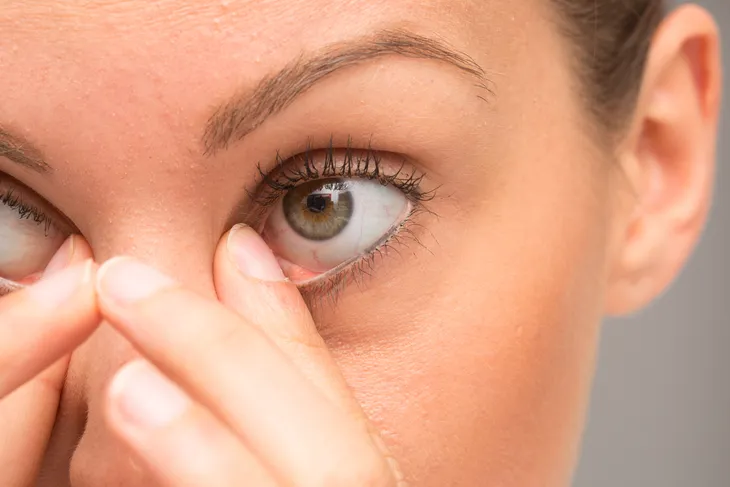Pink eye, or conjunctivitis, is a highly contagious bacterial or viral eye infection that occurs when the blood vessels of the transparent membrane (or conjunctiva) covering the whites of your eye becomes irritated and inflamed—thus causing the tissue to turn pink in color.
A pink eye infection can occur when the eyes are rubbed with dirty hands, typically spreading the bacteria and germs from an allergy or influenza infection into the eyes, or by using dirty contact lenses.
Here are the 12 most common itchy-scratchy symptoms of pink eye…
1. Discoloration in Whites of the Eye
Redness is one of the primary and most telling symptoms of pink eye. This red discoloration will affect the conjunctiva tissue, or the whites of the eyes, and typically only in the infected eye. However, proper steps to maintain hygiene in both eyes must be taken otherwise the infection can spread.
This discoloration occurs because the blood vessels on the surface of the eye become inflamed. Your eyelids may also become red or pink, and this can be checked by lightly pulling the lid away from your eye.
You’ll likely be tempted to rub your eye due to itchiness, and for a parent, it’s darn near impossible to stop an infant or toddler from rubbing their eyes. In this case, just make sure they wash their hands as regularly as possible.
2. Tearing
In rare cases, pink eye can occur due to overly dry eyes. For instance, you could end up with a nasty case of pink eye after a day of skiing if your eyes dry out from overexposure to wind and sun. In this case, you may experience a lot of tearing as the eye tries to lubricate and flush out the bacteria. This relubrication is your eye’s natural defense to protect and heal itself.
The discharge of the eye will help determine whether you have a viral or bacterial infection. If you experience clear fluid tearing and the pink eye isn’t from overly dry eyes, you likely have viral pink eye. Viral pink eye usually develops from cold viruses that attack the upper respiratory system. These types of viruses affect the fluids in the eyes, mouth and nose. Bacterial pink eye will cause thick, yellow or green discharge.
3. Chronic Itching
Itchiness is one of the most uncomfortable and chronic symptoms of pink eye. Because it’s difficult to refrain from rubbing, you must wash your hands constantly in order to stop from spreading the virus to your other eye or to someone else. Anyone living in the same household should also wash their hands regularly. This should go without saying, but it’s best to to avoid touching your eyes or mouth when you or someone around you has pink eye.
Your pharmacist may be able to suggest some eye drops that could help relieve some of the itchiness.
4. Thick Eye Discharge
A thick and unsightly discharge can form over the eye due to conjunctivitis, specifically if the pink eye is bacterial in nature. Once your eye gets red and discolored, discharge will develop. The discharge will appear thick and slightly white, yellow, or even green in color. Although you can and should wipe away discharge with a cloth, it’s common for the discharge to keep coming. You may have to keep wiping it away during the course of your infection, depending on the severity of the infection.
You may also notice that your eye crusts over during the night making it difficult and even painful to open it in the morning. This will happen until the infection clears up. To help with opening the eye, try using a washcloth that has been soaked in warm water. This will soften the crusty discharge, allowing you to open your eyes.
5. Inflamed Eyelid
If your conjunctivitis infection is severe, you may notice that the eyelid of your affected eye swells painfully. This swelling typically takes place only on the upper eyelid, and your eyelid may appear lopsided or droop to one side, which is a condition called pseudoptosis. Luckily, it’s typical for symptoms to last only 5 to 7-days, and they tend to clear up rather quickly if treated right away.
In some severe cases, the eyelid could swell so badly that you have trouble seeing or can’t see at all through the infected eye. Infants and young children can be especially difficult to care for if the swelling shuts one or both of their eyes. Unfortunately, infants are also more susceptible to contracting pink eye, and they have a higher risk of developing severe complications if left untreated.
6. Burning Eyes
A burning sensation typically occurs in the eye when your body is trying to eliminate dust, a rogue eyelash, or an infection such as pink eye. The burning you experience from pink eye is actually coming from your eyelids, not your eye. The constant itchy, burning sensation of pink eye will only last until the infection is gone. In some cases, the burn you feel can be so extreme that it’s painful.
There are a number of home remedies to help ease the burning. Try pressing a cool washcloth to the affected eye or try over-the-counter artificial tear eye drops. While you may be able to soothe the burning on your own, it’s important to know that burning eyes can also be a symptom of several other issues, including allergies, irritants from soap or shampoo, and other bacterial or viral infections. If you experience regular burning sensations in your eyes or eyelids, you should seek medical help.
7. Gritty Discomfort Inside the Eye
Many patients with pink eye describe the constant discomfort of having sand or dirt particles in their affected eye. With pink eye, the grit you feel is real and can be quite uncomfortable for long periods of time. You may feel this microscopic grit under your upper eyelid, and it may be particularly severe when your eyes are closed during the night, making it difficult to sleep comfortably.
It can be tempting to rub your eyes when you feel like there’s something in it, but doing so when you have pink eye will only irritate it more. To help decrease the grittiness, apply warm compresses to the infected eye to soften and break up the crusty discharge. This could prompt your eyes to naturally secrete the particles under your eyelid, giving you a break from the discomfort. During the worst of your pink eye infection, you may have to repeat using the warm compress several times.
8. Lymph Node Tenderness
Those suffering from conjunctivitis often also experience swelling and tenderness in the area in front of the ears. This pain is caused by the swelling of the lymph nodes, which become inflamed and tender in response to an infection. In some cases, you can actually see the swelling in your upper neck. Since many forms of pink eye are from bacterial and viral infections, it’s quite common for your lymph nodes to be tender.
The common cold can attack your whole upper respiratory system, resulting in a sore throat, runny or stuffy nose, and blocked or painful ears. Adding pink eye to this equation makes the infection that much worse. If you have a cold and start developing the signs and symptoms, it’s important to limit your interaction with other people. Pink eye is extremely contagious if caused by a bacterial or viral infection, so recognizing it early on is vital to prevent spreading it around.
9. Blurred Vision
It is also common for patients with pink eye to experience temporary blurred or altered vision. This will occur due to the inflammation of both the eye tissues and the eyelid. You may also experience a slight sensitivity to light until the infection is gone. If you wear contact lenses, you’ll likely have issues trying to put them in when you have pink eye, and it’s usually best to not wear for the duration of your infection. They can further irritate your eye, increasing the swelling and making it even more uncomfortable.
Because of the seriousness related to vision problems, even if it’s temporary, you should go to the doctor if you have any trouble seeing. Many other types of eye infections can cause blurred vision, and some of them can be quite serious. It’s best to confirm with your doctor that your vision problems are from pink eye and not a more worrisome infection or disease.
10. Sensitivity to Light
We all need a little time to adjust when going from a dark space and into the light, but when someone is suffering from an eye infection like conjunctivitis, the light sensitivity may be severe and even cause pain or vision changes. This will happen if the infection has become quite serious, says Health.com after talking to Gene Kim, MD, associate professor of Ophthalmology and Visual Science with the McGovern Medical School at UTHealth in Houston and a member of the Robert Cizik Eye Clinic. It could mean the infection has spread beyond the conjunctiva.
If you’re experiencing light sensitivity, both Health.com and SELF advise getting checked out by a doctor just to ensure nothing more serious is going on. “Antiviral medications or antibiotic eye drops or ointments can treat the condition and prevent long-term complications,” writes Health.com.
11. Contact Lenses Don’t Stay in Place
According to the National Eye Institute, pink eye can cause contact lenses to move around or simply not stay in place. They might begin to feel uncomfortable “due to bumps that may form under the eyelid.”
Not surprisingly, the source also advises anyone who wears contact lenses to not wear them once the symptoms of pink eye begin to appear. Also, if your symptoms don’t seem to be getting better after 12 to 24-hours, make an appointment with an eye doctor so that any more serious conditions can be ruled out.
12. When to See a Doctor
As we already mentioned when talking about light sensitivity, if the symptoms of pink eye become more serious beyond the normal itchiness and discoloration, you should go see a doctor, because there are eye conditions that are more serious that can cause similar symptoms. “These conditions may cause eye pain, a feeling that something is stuck in your eye (foreign body sensation), blurred vision, and light sensitivity,” writes the Mayo Clinic. The source encourages anyone who is suffering from those symptoms to seek urgent care.
Very Well Health adds that anyone who begins to show signs of a respiratory infection with swollen lymph glands should see a doctor because certain types of pink eye are extremely contagious. This is especially true for school-aged children who could easily spread the virus to other children or adults. The source also suggests seeing a doctor if symptoms don’t go away or get better after 2-weeks, and call a doctor immediately if pink eye accompanies a high fever (over 100.4-degrees Fahrenheit), a thick yellow or green discharge, severe pain when looking at light, or blurred, double, or vision loss. These could be signs that the infection has become more aggressive and needs treatment.















